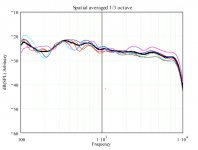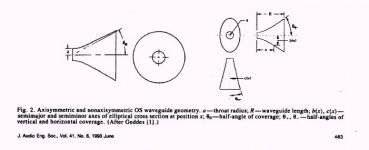Markus
I usually like to see the axial response being the same when the speaker is rotated. Theoretically this is the same point in all three cases. Yours appears quite different.
I usually like to see the axial response being the same when the speaker is rotated. Theoretically this is the same point in all three cases. Yours appears quite different.
For the vertical measurements the enclosure was rotated around the mid-point between waveguide and woofer. Furthermore there is the very early reflection from the stand and the table the speaker was placed on. Maybe that's why?
Best, Markus
Best, Markus
The colors for the upwards vertical data were wrong. Here's a corrected version:
An externally hosted image should be here but it was not working when we last tested it.
gedlee said:Markus
I usually like to see the axial response being the same when the speaker is rotated. Theoretically this is the same point in all three cases. Yours appears quite different.
I rotate about the midpoint of the enclosure. Early reflections off of the stand can be a factor. The point is that our measurements may differ in detail, but not so much overall.
Best I can tell, you've never published or posted the Nathan 10 verticals for comparison to Markus's data....gedlee said:I don't understand the question. What data set are you looking at? I can't comment on someone else's data, only my own. I will comment on the Nathan data shown on my web site, but I can't comment on the vertical data shown by Marcus, at least not in detail, until I have a chance to compare it with my own.
poptart said:Zilchlab, I'm too lazy to find the posts but Earl has said all along that the crossover is designed to make the flattest response at something like 20º off axis so the "lone flatish line"certainly isn't the on axis one.
Yeah, it is. Checking back, the known 6 - 7 kHz on-axis response anomaly appears prominently in each instance....

Obviously, and as Earl already clearly stated, this is a speaker optimized for horizontal off axis listening. No focus on the verticals.
So lets wait for Markus to arrange the whole system and fix it and listen well, so he will give us his opinion about some subjective impact and weighing priorities of the total concept.
So lets wait for Markus to arrange the whole system and fix it and listen well, so he will give us his opinion about some subjective impact and weighing priorities of the total concept.
gedlee said:I will post the vertical at some point, but owing to the fact that its not as good AND its not as important as the horizontal, I'm not in a hurray to do that. The point here is that no one else ever shows this data at all!!
He has just told us that the verticals are not as important to him BECAUSE he uses ceiling and floor room treatments to render them harmless, and listens on-axis vertically.
How many times has Earl unequivocally asserted that subjective evaluations of loudspeaker performance are meaningless and that design performance is all revealed in the measurements?
Again, let's get at the facts so that we can discuss them and each decide for ourselves what compromises are reasonable.
Markus has provided us with a peek behind the curtain here....

The measurements are objective but their priority hierarchically is subjective. I know people that like rather long ribbon tweeters and don't care about the limited vertical energy they provide. They only listen sitting down on axis, and appreciate the avoidance of some vertical boundaries reflecting. Others told me that they hate ribbons, they cant wander around walking without losing the HF bcs they do lots of casual listening along doing other stuff. I have seen people doing the sit down - sit up test all the time, even in hi-fi events as members of audience. I have asked one why is it so prior to him, and replied that if he moves vertically and has a strong clue that the sound changes, he can't psychologically forget that he is listening to loudspeakers and spoils the whole auditioning for him even when he sits back on right axis!
Due to the particular controlled dispersion and horizontal off axis advised listening in Earl's speakers I don't know how exactly the impact of total energy and reflections in all angles on room response is going to be perceived, even when listening on vertical axis. Maybe a room RTA at and around the listening head position averaged for 1m side window with all speakers and subs playing can give us an idea of what Markus is hearing since at least I live across the Hudson+Atlantic+Med Sea, and I will be late for that free beer!
Due to the particular controlled dispersion and horizontal off axis advised listening in Earl's speakers I don't know how exactly the impact of total energy and reflections in all angles on room response is going to be perceived, even when listening on vertical axis. Maybe a room RTA at and around the listening head position averaged for 1m side window with all speakers and subs playing can give us an idea of what Markus is hearing since at least I live across the Hudson+Atlantic+Med Sea, and I will be late for that free beer!
Zilchlab
I am disinclined to post something so that you can pick holes in it. That's clearly what you intend to do.
Salas - there actually are spatial RTA's of the Summas in my room with a 10 ms. window, which has the early refections in it. They are on my web site in the Powerpoint on Room Acoustics. At that time there was a bad ceiling reflection and this could be seen in the data. Thats why I treated the ceiling.
I am disinclined to post something so that you can pick holes in it. That's clearly what you intend to do.
Salas - there actually are spatial RTA's of the Summas in my room with a 10 ms. window, which has the early refections in it. They are on my web site in the Powerpoint on Room Acoustics. At that time there was a bad ceiling reflection and this could be seen in the data. Thats why I treated the ceiling.
gedlee said:Zilchlab
I am disinclined to post something so that you can pick holes in it. That's clearly what you intend to do.
What is clear is that you are here not only to promote your design principles, but also, now, your products, and by virtue of exploiting the advantages of using a public forum for these purposes, it should not be unreasonable to expect that public scrutiny would come with the territory.
My interest is largely an academic one, primarily in the comparative advantages of axisymmetric versus asymmetric waveguides in real-world implementations, which is a topic of discussion and debate in other forums.
As you and I have agreed in previous encounters, the facts speak for themselves, and you pride yourself in fullest exposition of the data. Ultimately, it will be known. Your reluctance to do so in this instance is abundantly apparent, notwithstanding any observations I might post regarding the measurements themselves.... 🙄
ZilchLab said:
What is clear is that you are here not only to promote your design principles, but also, now, your products ...
I have never made any secret of this and in fact have stated so on several occasions. The moderators know this and they agree that my approach is acceptable to them.
Your interest appears to be more like a vendeta than academic interest and I, like all manufacturers, reserve the right to show what I choose to show. I am not embarased at all by the performance of these systems in the vertical direction, but I will not be intimidated into doing something just to appease an unfriendly post.
Non-axi-symmetric wavguide won't elliminate the holes in the vertical response. The Yamaha data that I posted was non-axisymmetric. The holes result more from the spatial seperation of the drivers than anything else.
salas said:This one? Has an agreeable ''house curve''.
Yes, thats the one. This was, by the way, many years ago and before I used the three subs that I use now. The low end is much smoother these days and the 200 Hz. dip was the ceiling reflection. I should take some more recent data - but there are a lot of things that I "should do".
gedlee said:Non-axi-symmetric wavguide won't elliminate the holes in the vertical response. The Yamaha data that I posted was non-axisymmetric. The holes result more from the spatial seperation of the drivers than anything else.
Indeed, however, axiasymmetric provides the potential for a reduced center distance which, according to the Linkwitz formula, moves the vertical nulls further away from the central axis, thereby expanding the available vertical listening beamwidth remaining free of aberrant response.
Further, since the vertical beamwidth is also narrower, ceiling and floor reflections are reduced throughout the rest of the HF response above the crossover region, and what reflections ARE present exhibit a more uniform power response the wider it is possible to space the nulls.
And finally, you suggest that it would be a trivial matter to "fix" the on-axis response anomaly characteristic of axisymmetric waveguides using this approach, obviating the necessity of employing a contrived horizontal off-axis listening alignment.
None of this is news to you, of course:
Attachments
ZilchLab said:
None of this is news to you, of course:
Quite correct, which makes me wonder why you even make these statements - clearly not for my benefit.
I am building the prototype of an elliptical waveguide as we speak, however, the difficulties are substantial and there is no certainty that they will ever see production or at what price. But I do want to test the various "hypothesis" that abound about their effectiveness. They would end up being nearly double in cost and I wonder what kind of performance increase would be necessary to justify this kind of price increase? There is no way that they will sound "twice as good"! In fact they may not even "sound" any better!!
I strongly believe that one of the main features of my designs is that I do "what's necessary" for good sound and not whats "perceived" to be required (i.e. in vogue). I am inclined to think that the small problems that an elliptical waveguide may help to solve may not be all that audible and hence substantial cost is added with no sound quality benefit. This would go against my entire belief in "value" in obtaining good sound quality. I may as well go out and buy a $6000 amp / preamp to replace my $200 Pioneer receiver.
salas said:This one? Has an agreeable ''house curve''.
A critical point to make here about that curve is that it was obtained with absolutely no EQ. I can't overstress enough the importance of this fact and it is no coincidence. If EQ is used to create a smooth "house curve" then the speakers direct field is no longer flat. ONLY with CD is it possible to get house curves like that with a perfectly flat direct field.
I may as well go out and buy a $6000 amp / preamp to replace my $200 Pioneer receiver.
I am glad to see you are finally replacing that low-end receiver!

There were six people here yesterday for a listening session. The single most "upsetting" thing to them was my receiver. It kind of deflated everything that they though that they knew about audio. Oh well, thats why I'm here, to antagonize and upset as many people as possible with the outrageous truth about audio.😀
- Status
- Not open for further replies.
- Home
- Loudspeakers
- Multi-Way
- Setting up the Nathan 10

